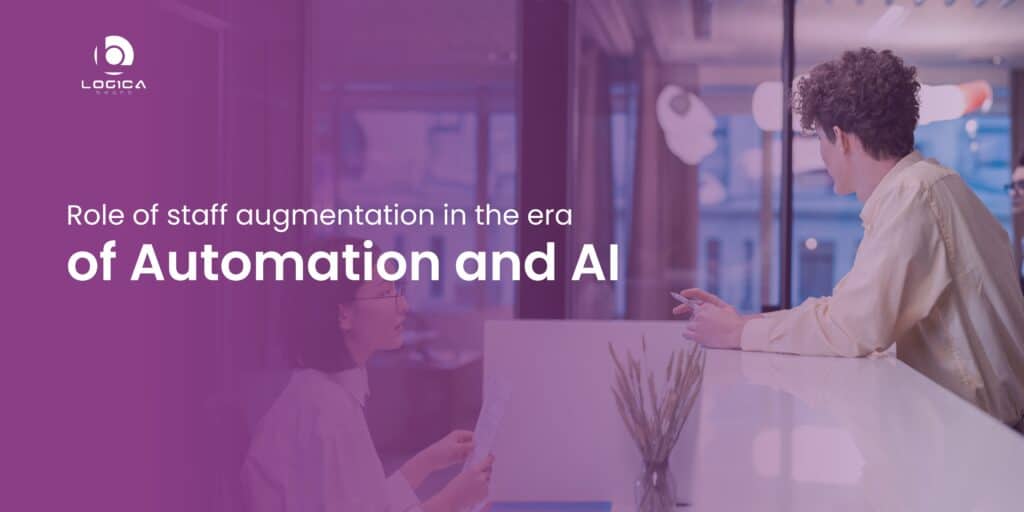Automation and artificial intelligence (AI) are being used increasingly across a variety of sectors as technology advances. These innovations have been utilized by several firms to boost efficiency and simplify operations. Concerns have been voiced concerning the effects on the workforce, though. Many people worry that AI and technology will replace human labor and make some occupations obsolete.
In reality, the use of technology has produced new job openings, and the importance of staff augmentation in the era of automation and AI in ensuring that firms can remain competitive in today’s dynamic economy continues to be paramount.
In this blog, we’ll explore the applicability of staff augmentation in the era of automation and AI and how it may be used to provide companies with the adaptability, scalability, and specialized skills they need to thrive in today’s dynamic environment.
Staff augmentation in the era of automation and AI
The importance of staff augmentation has grown in the age of AI and automation. The use of technology has altered how organizations run, and there has never been a greater demand for talented personnel who can adapt to these changes. Businesses can prosper in this changing climate by using staff augmentation in the era of automation and AI, which gives them the flexibility, scalability, and specialized capabilities they need.
The capacity to swiftly grow the workforce to meet shifting demands is one of the key advantages of staff augmentation in the era of automation and AI. Businesses must be able to swiftly adapt to new technologies and shifting market conditions given the development of automation and AI. Businesses may swiftly address skill shortages in their workforce and adapt to changing demands by bringing in temporary workers with specific abilities without the long-term commitment and added price of recruiting permanent personnel.
However, even if automation and AI have the ability to automate a variety of jobs, many other tasks still call for the knowledge and abilities of people. For instance, it is difficult to automate tasks requiring creativity, emotional intelligence, and critical thinking. Businesses can gain these abilities through staff augmentation in the era of automation and AI and use them to drive innovation and growth.
The era of automation and AI
The terms “automation” and “artificial intelligence” relate to the use of technology to automate formerly human-performed jobs and processes. Automation is the use of equipment, software, and other technologies to carry out routine activities or processes with little or no human involvement. These might include straightforward procedures like email screening or more intricate ones like inventory management.
On the other hand, AI uses machine learning and algorithms to evaluate data and generate predictions. To do tasks that were previously assumed to need human intellect, such as recognizing voice, pictures, and patterns, AI systems may learn from data and develop their performance over time.
By increasing productivity, lowering expenses, and opening new business models, automation and AI have the ability to completely change how firms’ function. Automation, for instance, may assist organizations in automating monotonous processes, freeing staff to concentrate on more important work. By analyzing vast volumes of data and spotting patterns and trends that people would be unable to spot on their own, AI can assist organizations in making better decisions.
But still there are also concerns about how automation and AI will affect the workforce. While these technologies may open new employment prospects, they may also result in the loss of jobs for employees who lack the necessary skills to adapt to the evolving labor market. As a result, it’s critical for businesses to use automation and AI in an ethical and responsible way. They also need to invest in retraining and upskilling their workforce to prepare them for the jobs of the future.
Advantages of automation and AI
● Increased efficiency
Workplace productivity may be increased by using automation and AI technology, which can complete jobs and procedures more quickly and accurately than people. For instance, a machine learning algorithm can swiftly evaluate vast volumes of data and offer insights that would require people to acquire and interpret them over a much longer period of time.
This may result in quicker decision-making and better problem-solving, which will eventually increase the business’s overall efficiency. Automating repetitive and low-skill jobs may also save time and money, freeing up human workers to concentrate on more strategic and complicated duties. Employees are able to apply their knowledge and abilities more effectively, which boosts work satisfaction and overall performance. This enhances production.
● Cost reduction
By automating routine and low-skill work, automation and AI technologies can also assist organizations in lowering labor expenses. Businesses may see considerable cost savings because of not needing to hire as many employees to complete these jobs. Automation can also lessen the chance of mistakes and rework that can happen when humans do repeated operations, further lowered costs and boosted efficiency.
Businesses may free up human resources to work on more complicated and strategic jobs that call for creativity and critical thinking by automating these processes, which will eventually provide more value to the corporation. One of the main benefits of automation and AI technology is cost reduction, which may help firms increase their bottom line while also increasing productivity and efficiency
● Improved safety
By doing risky or hazardous jobs that endanger human workers, automation and AI technologies can also contribute to increase workplace safety. Robots can be utilized, for instance, to carry out jobs in hazardous conditions for people, such as working with harmful chemicals or in scalding heat. Employees will work in a safer atmosphere as a result of the decreased chance of accidents or injuries.
AI-powered solutions may also be used to monitor workplace security and spot possible risks before they endanger workers. By doing so, firms can lower their risk of liability and prevent accidents. Automation and AI technologies may safeguard workers by enhancing workplace safety, but they can also enhance the company’s credibility and image.
● Enhanced customer experience
The ability to provide individualized and prompt support through chatbots and virtual assistants powered by AI is another benefit of automation and AI technology. The whole customer experience may be improved by using these technologies to give help round-the-clock and swiftly and properly react to client inquiries. Natural language processing and machine learning techniques may be used by AI-powered chatbots to identify client requirements and make tailored recommendations, giving them a sense of being valued and heard.
Automation can also assist in speeding up customer service, decreasing wait times and raising customer satisfaction. Businesses may boost customer loyalty and retention, which will result in more sales and expansion, by improving the customer experience. Overall, organizations may offer superior customer service by using automation and AI technology.
● Data driven decision
The benefit of automation and AI technologies is that they may support data-driven decision-making in enterprises. Automation can gather and analyze data more quickly and correctly than people, giving organizations useful information they can utilize to enhance operations and financial results. For instance, machine learning algorithms can examine consumer data to spot patterns and trends, assisting organizations in better comprehending the wants and preferences of their clientele. This may result in more successful marketing tactics, higher levels of client satisfaction, and eventually, more sales.
Automation may also assist companies in identifying areas where they can save expenses or boost productivity, such as supply chain optimization or better production methods. Businesses may remain ahead of the competition and find long-term success by making data-driven decisions. Generally speaking, automation and AI technologies can help businesses harness the power of data to make better decisions and drive business growth.
Impacts of automation and AI on business and employment
Automation and AI technology adoption is anticipated to have a significant influence on industry and jobs. While these technologies may open new employment prospects, they may also result in the loss of jobs for employees who lack the necessary skills to adapt to the evolving labor market. A McKinsey Global Institute analysis estimates that by 2030, automation may force up to 375 million employees to change careers.
Moreover, it is anticipated that the adoption of automation and AI technologies would result in the emergence of new employment categories requiring highly specialized technical and analytical abilities. To prepare their workforce for the occupations of the future, businesses must invest in the reskilling and upskilling of their workforce. This requires a planned and responsible approach to the use of automation and AI. Increased productivity, a better customer experience, and more resilient and competitive organization may all result from the efficient integration of automation and AI technology into the workforce.
The change in the power dynamics between employers and employees is one such effect. Automation and AI may provide companies with more negotiating leverage over employees, making it harder for workers to demand better compensation and working conditions. This can result in a wider income disparity and more workplace inequality.
The ethical issues surrounding the employment of automation and AI technology might have an additional influence. For instance, there can be worries about the use of AI-powered decision-making systems, which may sustain prejudices and discrimination, in situations like employment or loan choices.
The environment may potentially be affected by the introduction of automation and AI technology. These technologies may result in more effectiveness and less waste, but they may also increase energy use and carbon emissions.
Businesses must employ automation and AI technology responsibly and ethically to address these possible effects. This entails making investments in the education and training of their personnel, ensuring that workers are treated fairly, and resolving any possible prejudices or ethical issues.
In general, companies and the workforce face both possibilities and problems because of the deployment of automation and AI technology. Although these technologies have the potential to boost productivity, efficiency, and creativity, they also push companies to adapt to shifting job demands and make investments in the abilities and wellbeing of their personnel. Businesses can utilize the promise of automation and AI to spur development and add value for all stakeholders by adopting a prudent and planned strategy.
Role of staff augmentation in the era of automation and AI
Staff augmentation can be essential in the age of automation and AI for businesses looking to take advantage of these developments. While automation and AI can boost productivity, speed, and accuracy, some activities and projects still call for the knowledge, discretion, and creativity of people. By utilizing staff augmentation, businesses may access outside expertise who can collaborate with AI and automated technologies to get better outcomes.
Here are some of the roles of staff augmentation in the era of automation and AI
● Combining human expertise with automation and AI
A key component of fusing human knowledge with automation and AI is staff augmentation. There are still some activities and projects that require human knowledge, discretion, and originality, even though automation and AI can boost efficiency, speed, and accuracy. Using the talents and expertise of outside specialists who can collaborate with AI and automated technologies to get better results is possible for businesses through staff augmentation in the era of automation and AI.
● Soft skills in an automated workplace
Soft skills like teamwork, communication, and problem-solving become even more crucial as more activities are mechanized. Organizations can use staff augmentation in the era of automation and AI to discover people with the soft skills required to function well in an automated workplace. These people may assist in bridging the gap between automated systems and human users, maximizing the advantages of automation and AI.
● Innovation
In order to stay ahead of the curve and spot new chances for development and innovation, staff augmentation in the era of automation and AI can provide firms with access to cutting-edge experience and knowledge in AI and automation. For instance, firms might hire temporary AI and automation specialists to assist them in implementing new technologies or creating new goods or services.
These professionals may assist businesses with data analysis and discovery of fresh patterns and insights that can be applied to enhance operations and consumer experiences. Moreover, staff augmentation in the era of automation and AI can provide businesses access to a variety of viewpoints and talents that might encourage innovation.
Best practices for implementing staff augmentation in the era of automation and AI
In the age of automation and AI, implementing staff augmentation needs careful planning and execution. Here are some recommendations for optimal practices:
● Assessing organizational needs and gaps
Prior to working with a staff augmentation partner, it’s important to evaluate the needs and gaps inside the business. This entails determining the business sectors that stand to gain from automation and AI as well as the knowledge and abilities required to properly integrate and manage these technologies. Organizations may use this evaluation to identify the necessary kind of staff augmentation in the era of automation and AI, the length of the engagement, and the precise skills needed.
● Choosing the proper partner for staff augmentation in the era of automation and AI
Selecting the correct partner is crucial to the success of staff augmentation in the era of automation and AI. Companies should seek partners with knowledge of AI and automation as well as a track record of providing top-notch personnel and services. Evaluation of the partner’s cultural fit, communication style, and adaptability to working with the organization’s current systems and procedures are also crucial.
● Building a strong communication and collaboration plan
Creating a solid plan for communication and cooperation is essential for staff augmentation in the era of automation and AI since it calls for efficient interaction between the company and the partner. Setting up a communication strategy, defining roles and duties, setting clear expectations, and giving frequent feedback are all part of this. To guarantee a seamless integration, it’s crucial to create open lines of communication between the existing team and the expanded employees.
● Monitoring and measuring the success of staff augmentation
Organizations should set metrics to evaluate the effectiveness of the engagement to make sure that staff augmentation in the era of automation and AI is achieving the desired goals. This involves keeping track of performance indicators including output, quality, and customer satisfaction as well as keeping an eye on the partner’s compliance with the set scope, timetable, and budget.
● Providing appropriate training and support
Even though staff augmentation gives access to specialized expertise, it’s also crucial to give the augmented employees the proper training and support to make sure they are aware of the organization’s procedures, policies, and culture. This can assist close any knowledge gaps that could emerge and guarantee that the enlarged personnel can effectively collaborate with the current team.
● Handling risks and security
Automation and AI may pose dangers and security problems, and if these issues are not appropriately handled, staff augmentation may make them worse. For augmented workers, organizations should set clear security standards and guidelines and make sure they follow such policies and procedures.
● Continually reviewing and revising the staff augmentation plan
Lastly, it’s critical to continuously review and revise the staff augmentation plan in light of evolving organizational demands, new technology, and other considerations. This may guarantee that staff augmentation keeps adding value and is consistent with the goals of the company.
Overall, successful staff augmentation in the era of automation and AI requires a comprehensive and strategic approach that accounts for the unique challenges and opportunities of these technologies. By implementing these best practices, organizations can leverage the benefits of staff augmentation in the era of automation and AI while minimizing potential risks and challenges.
Conclusion
As the pace of technological change continues to accelerate, the role of staff augmentation in the era of automation and AI in the workforce is likely to become increasingly important. Staff augmentation in the era of automation and AI offers organizations a way to access specialized skills and expertise, reduce costs, and remain flexible and adaptable in the face of changing business needs.
Automation and AI will inevitably be adopted, and this will continue to influence how the workforce is organized in the years to come. While there are many advantages to this shift, there are also difficulties and possible concerns, notably in terms of job loss and economic inequality. As a result, it’s crucial for businesses to handle staff augmentation in the era of automation and AI and the adoption of new technology in a deliberate and intelligent manner, taking into consideration the wants and demands of their workers as well as those of other stakeholders.










